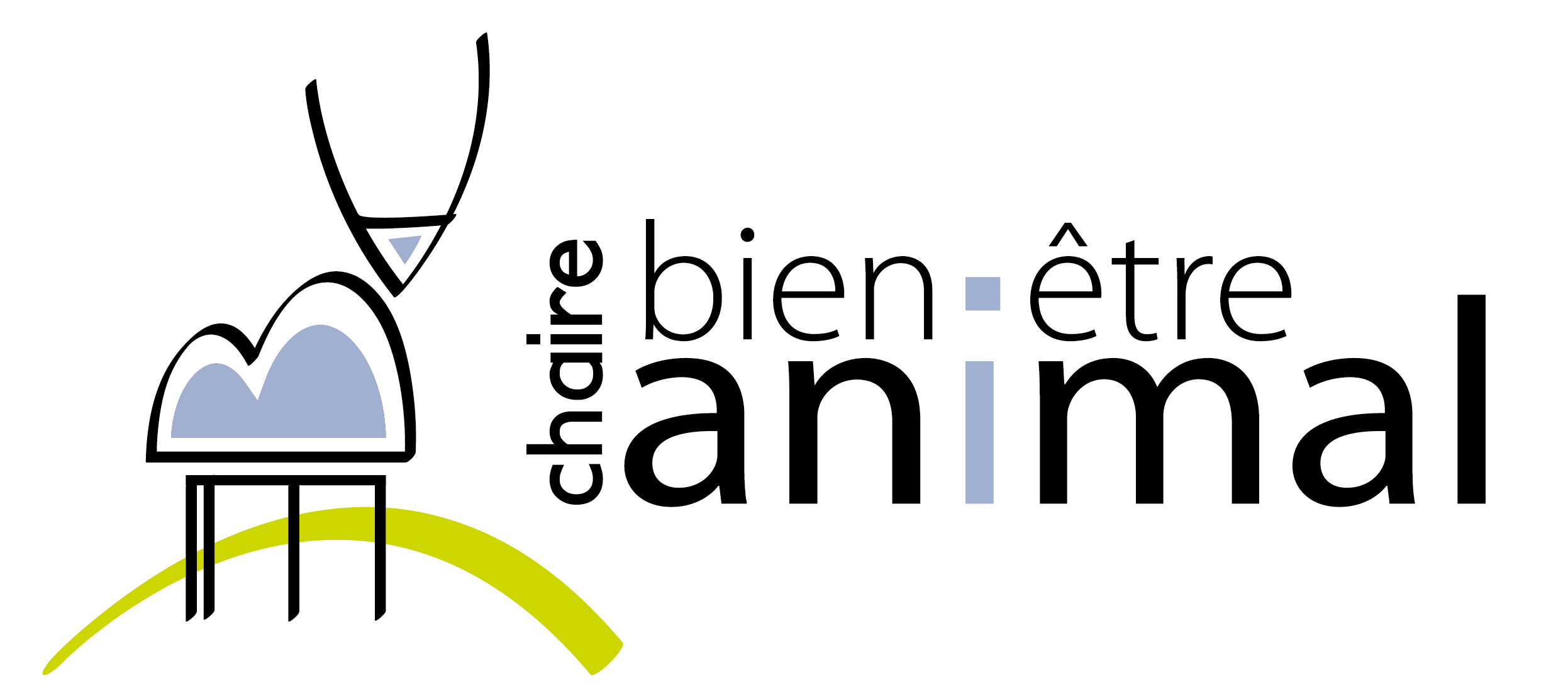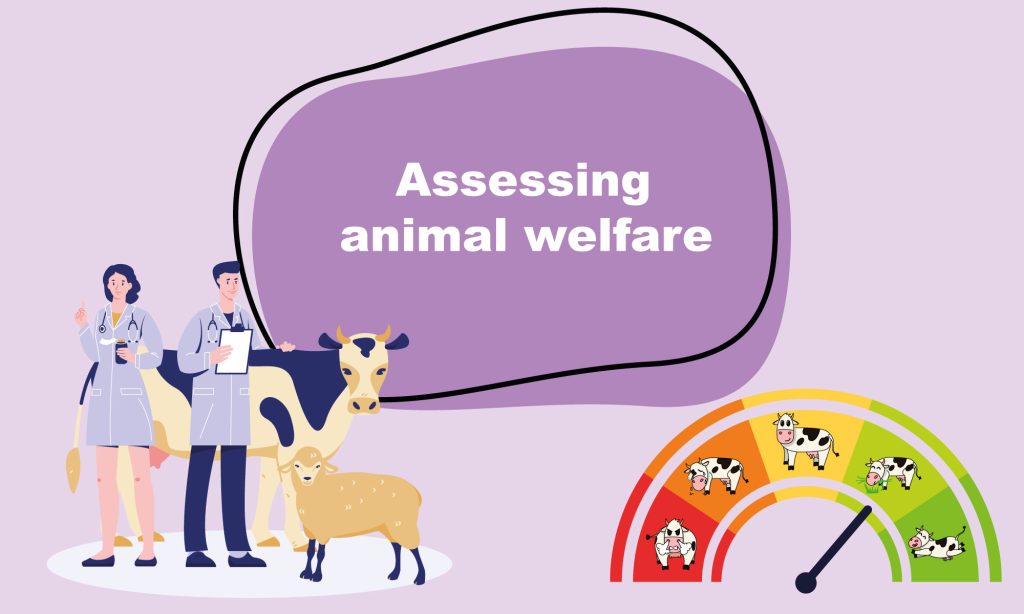
Various contexts of animal welfare assessment
Many stakeholders are committed to improving animal welfare, whether in the area of animal husbandry or domesticated animals. More and more consumers want to know about the animal welfare level of the food products that they purchase.
A welfare assessment of an animal or group of animals is a necessary step to achieve this goal.
This evaluation can take place in different contexts:
- Breeders who wish to assess the welfare of their animals in order to initiate an improvement process. This assessment can be carried out by the breeders themselves – as part of a self-diagnosis – or by a livestock specialist or veterinarian, for another perspective. This evaluation is the first step of what is called the “improvement loop”, i.e. the uninterrupted and progressive improvement of welfare in the farm.
- Breeders who wish to adopt a quality approach, obtain an official sign of quality such as a label, or to comply with different existing initiatives – such as the “animal welfare” label. Evaluation then guarantees that the farm meets certain criteria with regard to animal welfare.
- An official control, carried out by State services, to ensure that the farm follows the existing rules.
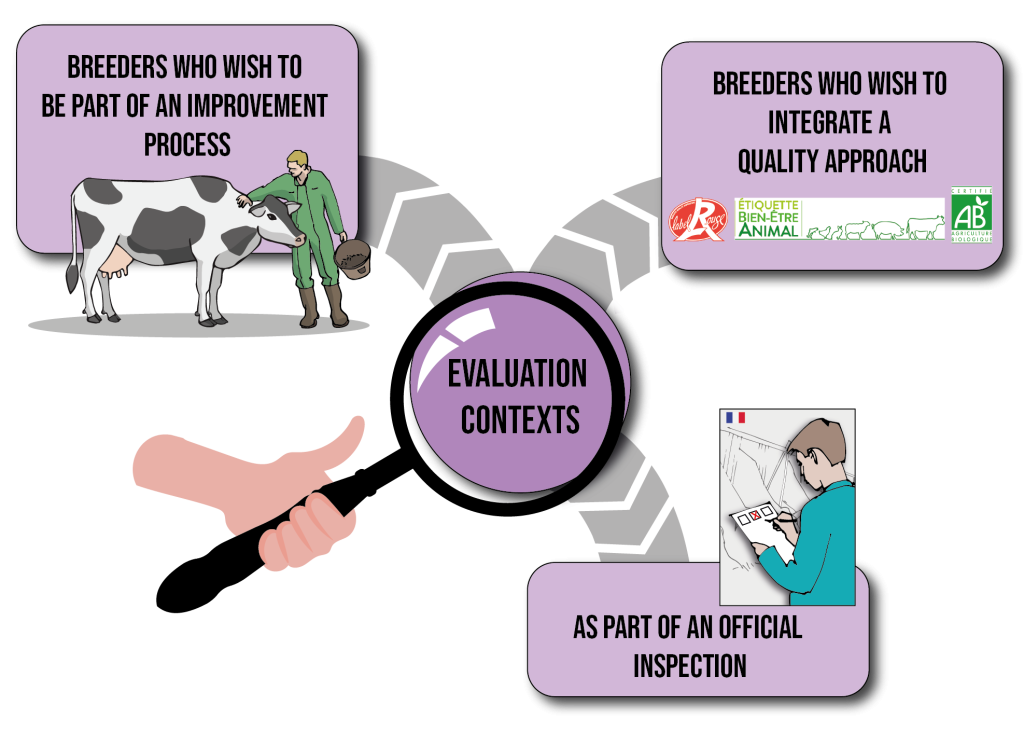
This video recaps what we have just discussed:

In all contexts, the assessment must be based on objective, scientifically validated criteria and indicators that truly reflect animal welfare.
ℹ️ To go further, you may want to see:
▪︎ This video on labels‘ animal welfare requirements
▪︎ This video on the improvement loop
▪︎ This interview of Jean-Philippe Piot, Ecocert auditor, who certifies organic farms
▪︎ This Danone guide for dairy breeders
▪︎ This Danone guide for veterinarians
Indicators of welfare
Let us recall that animal welfare is a multi-criteria issue and that all criteria must be evaluated. Depending on the definitions or protocols, the five freedoms or the Welfare Quality® protocol, for example, can be used as a basis.
The evaluation of each criterion is based on one or more indicators.
When applied to animal welfare, an indicator allows a quantified value to be assigned to a welfare criterion assessed on the farm. Sometimes, a single indicator is sufficient to assess a criterion, sometimes several indicators are necessary. For example, the indicator ‘body condition score‘ is sufficient to assess the criterion ‘absence of hunger‘ in dairy cattle, whereas two indicators are used to assess the criterion ‘expression of other behaviours‘ in sows: the number of stereotypies and exploratory behaviour.
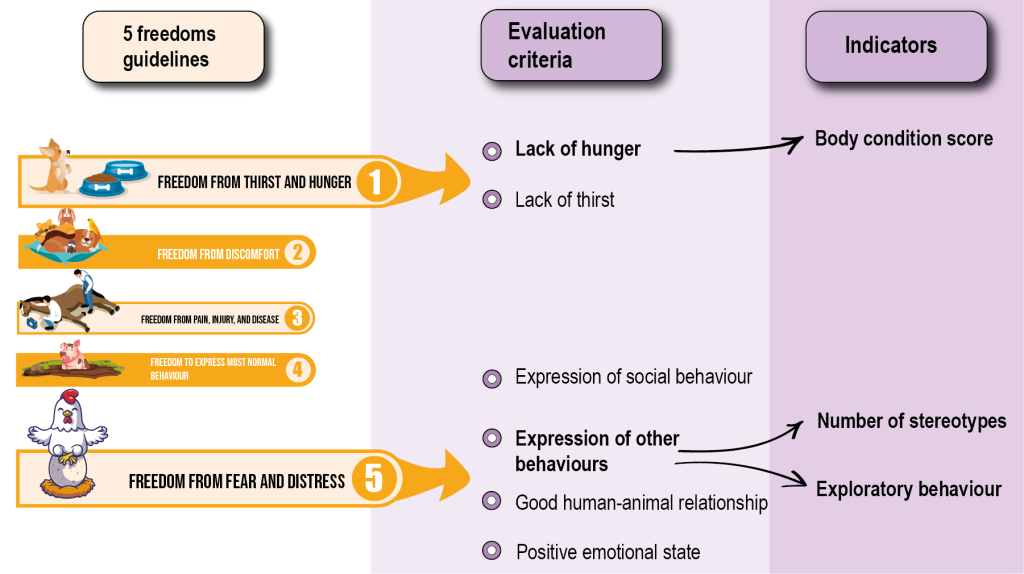
Where more than one indicator is used for a criterion, it is necessary to combine the results of these indicators to obtain the score. Similarly, the results of the different criteria will be needed to obtain an overall animal welfare score.

Remember
➤ There is no single valid indicator for all animal welfare criteria. Several indicators must be used.
➤ It is interesting to note that the majority of indicators used are mainly negative indicators (presence of wounds, unsatisfactory cleanliness, presence of disease, difficulty getting up, etc.) and more rarely indicators that assess the positive welfare status of animals.
The two main categories of indicators
Two broad categories are generally used for welfare assessment:
- Environment-based indicators (also known as resource-based indicators) measure the living conditions provided to the animal and are used to assess whether the given environment is conducive to welfare and good treatment. Environment-based indicators are most useful for assessing risk factors that may be causing welfare degradation.
- Animal-based indicators, which are based on direct observation (behaviour, health status, etc.) or indirect observation (production, longevity, etc.) of the animals and which ensure that the animal’s welfare is satisfactory under the conditions provided.
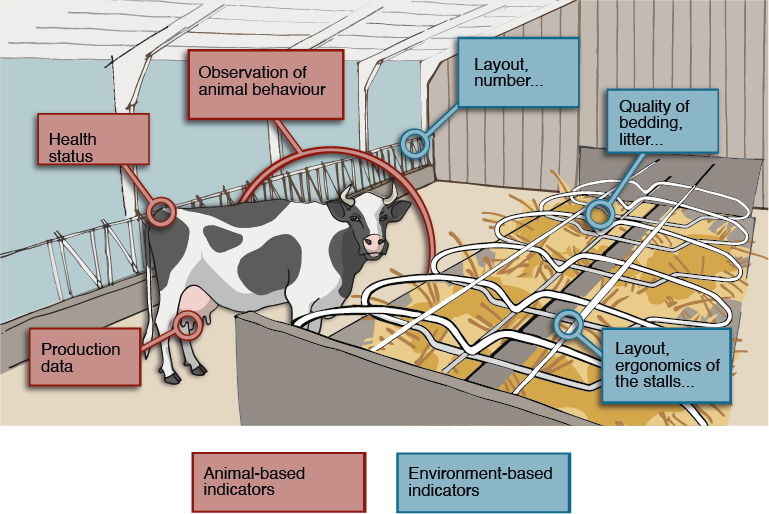
(crédit : Sabine Li)
For a video summary of what we have just discussed:

Remember
▪︎ Environment-based indicator ➡︎ Assessment of good treatment ➡︎ Obligation of means
▪︎ Animal-based indicator ➡︎ Welfare assessment ➡︎ Obligation of results
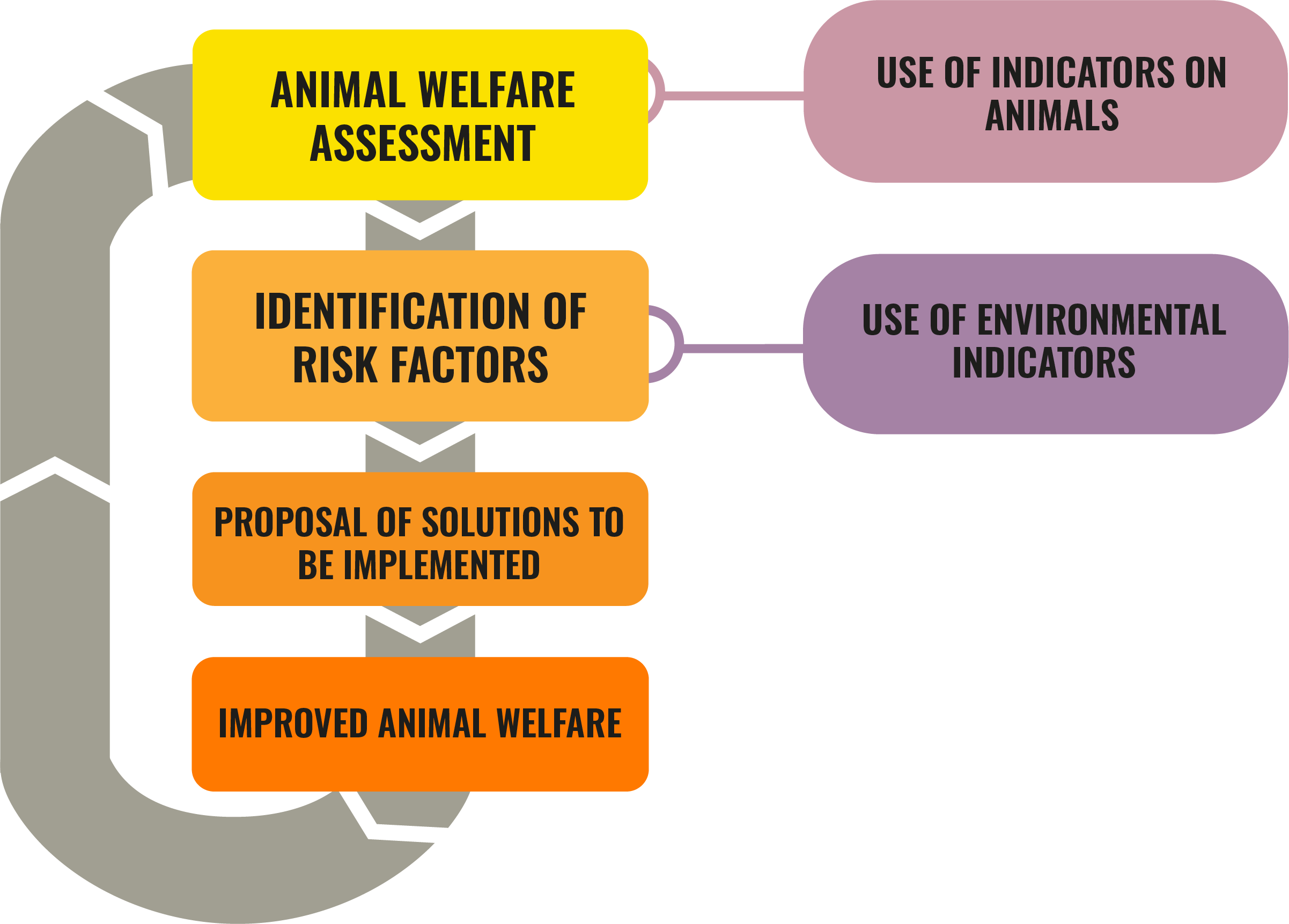
The main types of animal-based indicators
When an animal perceives its living conditions as a constraint, it reacts and tries to adapt. The animal’s adaptive responses may be behavioural or physiological and may have consequences for its production or health. It is these changes that the observer will use to assess the degradation of animal welfare.
Depending on the intensity and origin of the constraint, one or more of these types of indicators will appear. And some are generally more sensitive than others. Behavioural indicators are usually considered to be the earliest visible indicators, followed by physiological indicators. Health and production indicators are, in most cases, less sensitive and less quickly or easily modified in the face of stress.
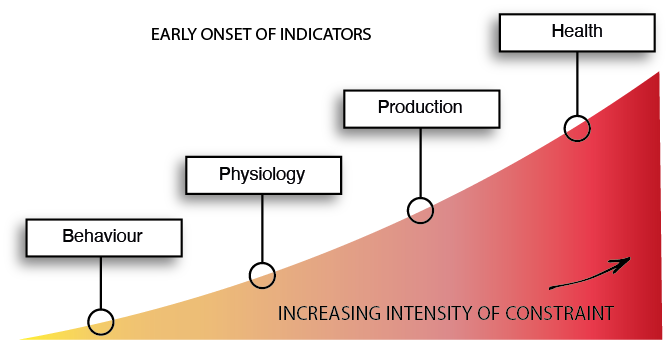
Behavioural indicators
Behavioural indicators are related to the modification of an animal’s behaviour.
[expand title= »For more information »]These are generally the most sensitive indicators, i.e. they will be modified at an early stage if welfare deteriorates: therefore, assessors should use them… and everyone should know about animal behaviour in order to be able to assess animal welfare!
There are two main types of behavioural indicators: changes in the animal’s activity and changes in its reactivity.
- Changes in the animal’s activity: this can be a modification of the frequency of its normal behaviour. For example, a cow must spend 10 to 14 hours a day lying down… if it only spends 6 hours lying down, we can suspect a problem related to the criterion « comfort of bedding ». It can also be the appearance of abnormal behaviour. This is the case, for example, of what is called stereotypies[1], which are behaviours that should not be observed if the animal’s welfare were satisfactory.
- Changes in the animal’s reactivity: the animal will overreact or will remain prostrate and less reactive.
To go further:

Remember
Observing an animal’s behaviour is essential to assessing its welfare.
Physiological indicators
These are the indicators that relate to the physiology of animals, and particularly stress responses.
[expand title= »For more information »]These are indicators of stress, such as increased cortisol concentration in the blood. Since they require an intervention on the animal (e.g. blood sampling), they are not used very often in current practice and are rather observed in welfare research.
[/expand]Production indicators
Here, the goal is to analyse the variations in animal production in order to assess their welfare.
[expand title= »For more information »]Stress reactions are generally energy consuming. Moreover, when faced with a constraint, animals often eat less. These two parameters combined mean that a decrease in production can be observed in the face of a constraint. The main production indicators include milk production, egg production, animal growth and reproductive parameters.
It is more useful to observe the drop in production than the actual production itself, because production depends on many factors that are not necessarily related to welfare (e.g., animal genetics or type of production). On the other hand, if production starts to decrease, we can suspect a problem with the animal’s welfare.

Remember
Production and welfare are closely linked. Improving animal welfare often improves production.
Health indicators
They concern the animal’s health status, i.e. the appearance of diseases, lesions, lameness, etc.
[expand title= »For more information »]Health indicators are not very sensitive and therefore appear late in the face of constraint. However, they are particularly important to monitor because when they appear, they generally worsen the animal’s situation and starts a vicious circle of reduced welfare. For example, an animal that limps will have more difficulty getting up or lying down, which may increase its lameness.
[/expand]Measuring these indicators
It can be a number (for example, a number of behaviours observed during an hour), a score on a rating scale (a lameness of 3 on a scale of 5) or the observation of a presence/absence (presence of a disease).
The result obtained is then associated with a level of welfare for the criterion evaluated.
How each indicator is measured depends on the indicator and the protocol used. It is important to be familiar with these before using them.
Vetting these indicators
Without going into detail here, the indicators used in assessment protocols must meet certain characteristics to be validated (feasibility, repeatability, etc.). When using a protocol or when you want to know about the animal welfare level of a food product, it is therefore important to make sure that the indicators used are scientifically validated. For example, the indicators of the Welfare Quality® protocol have been validated by scientists.
The integration process
The integration process is the shift from an indicator measured on an animal for a given criterion to an overall score for all the animals in the herd.
Integration’s goal is to obtain a result that is representative of the herd
The challenge here is to move from an individually measured score to a score representative of the welfare level of the whole herd.
[expand title= »For more information »]Most indicators are measured at the individual level. For example, the body condition score[2] will be assessed for each animal.
Other indicators are measured only once, for all animals. For example, the Qualitative Behaviour Assessment is a general description of how the herd behaves.
In the first case, it is necessary to combine the result obtained for each animal evaluated in order to obtain a herd score. Different processes exist to do this. In order for the evaluation to be as accurate as possible, it is necessary to either observe all the animals in the herd, or to observe a sufficient number of diverse animals to be representative of all the animals.
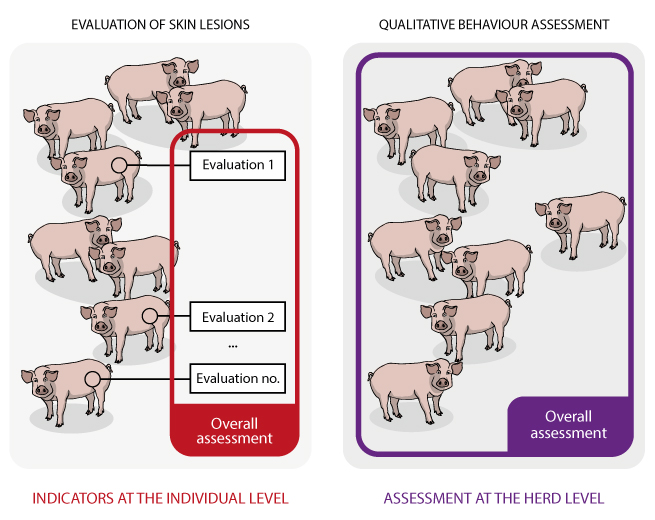
(crédit : Sabine Li).
Integration of the different criteria to obtain a welfare score
Since welfare is multi-criteria, the scores obtained for each criterion must be combined, integrated, to obtain an overall score. Depending on the purpose of the evaluation and the protocol used, the integration process can take different forms.
[expand title= »For more information »]We will only present here the integration proposed by the Welfare Quality® protocol, which allows for a global evaluation of welfare. This protocol is based on 4 principles, derived from the five freedoms:
- Good nutrition
- Good housing
- Good health
- Appropriate behaviour (combines the freedoms “Freedom to express most normal behaviour” and “Freedom from fear and distress”).
To be evaluated in the field, these principles have been broken down into 12 criteria. Each principle includes 2 to 4 independent criteria. Finally, indicators have been selected to evaluate each criterion.
| Principles | Criteria |
| Good nutrition | No prolonged hunger No prolonged thirst |
| Good housing | Sleeping comfort Thermal comfort Ease of movement |
| Good health | Absence of injuries Absence of diseases Absence of pain due to breeding practices |
| Appropriate behaviour | Expression of social behaviour Expression of other behaviours Good human-animal relationship Positive emotional state |
Once all indicators have been measured on the animals, a single herd score is calculated for each indicator. Scores of indicators contributing to the same criterion are then combined to obtain a criterion score. Scores of criteria contributing to the same principle are combined to obtain a principle score. The global score is determined according to the scores of the 4 principles. The overall score is divided into 4 categories: « excellent, » « improved, » « acceptable, » and « not classified”.
In the interest of the animal, and since welfare is multi-criteria and all criteria are important, it is preferable that no trade-offs be accepted, and that no one criterion or principle be totally ignored in favour of another. Some weighting is possible, however, if certain criteria are deemed to be « more important » to the animal’s welfare.

You’ve got it all figured out and you want to go even further?
1. Feel free to download the booklet “Evaluating animal welfare” published by Quae.

2. To put your knowledge into practice, play this serious game that will make you assess the welfare of dairy cows in a virtual farm!
[1] Stereotypy is defined as a behaviour that is « repetitive, unchanging, and has no apparent purpose or function » (Mason, 1991). Back
[2] The state of fattening, so to speak. Back

